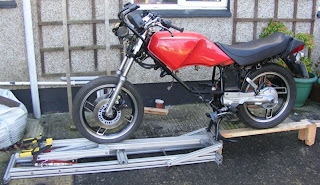These starter clutches are well known to the forum members for failing due to the screws undoing. The Haynes manual says to tighten to a torque with loctite applied.
Unfortunately this is not sufficient to stop the bolts undoing.
The forum suggests getting 2mm longer bolts and riveting the ends over.
Taking my side cover off and trying the clutch mechanism seemed to work perfectly well and so I thought mine had not suffered from the loose screws.
The wiring from the stator had some bare wires showing, so I decide to get it out for repair.
The rotor had to come off and with pullers and a gentle tap it eased off. Normally these parts fly off once released but the key was a bit stiff so mine all came off quite slowly.
Now I could see the damage, the screws were just held on with one thread.
As shown in the 1st picture is the damage to the back of the rotor caused by the loose screws.
The burrs around the screw holes were ground off with a dremmel so the surface was flush.
Surprisingly only the end of the thread had been worn away, the rest of the thread was tight so I retapped the threads with an M8 solid tap.

Next picture shows the damaged bolts but luckily the cage and rollers were undamaged.

I found some M8x16 allen bolts and drilled a 3mm hole x 3mm deep.

Final picture shows the screws in place with the hole expanded with a centre punch.
Another job was to make the rotor fit correctly on the taper. A previous owner hammer the end of the rotor so it formed a ridge on the inner taper. This had the effect of the rotor clamping on the ridge and not the taper allowing it to rock slightly. This ridge was ground away with the dremmel and now has a bite to the taper when putting the parts together.

A final big thanks to the riders of Vision forum for the fix for this problem.











